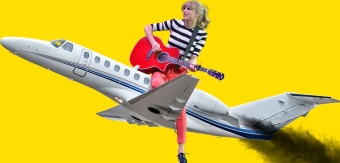We’ve already looked back at the year that was 2023 and what a year it was. But what kind of magazine would we be if we didn’t also cast our sights on the next 12 months?
Of course, there are a few trends you can expect to see pop up more than a handful of times (AI, anyone?) but 2024 promises to be more than just the year of the machines.
Our wealthy selection of industry experts imagines a 2024 that’s funnier, looser, smarter, more collaborative and more creative and I for one can’t wait to greet it with open arms.
Yifei Chai, Executive Creative Director @ UNIT9

In 2024, brands will have to become more human in their design and advertising so as to differentiate themselves in our increasingly AI-driven world. How? By moving even further towards meaningful engagement and cultural relevance to prioritise talkability and long term appeal.
In addition to the usual culprits that drive brands' need to be more meaningful - such as the economic climate making audiences take more care over their purchase decisions, and increasing expectations around brands following through on purpose and authentic communication - there’s a new driver in town: everyone’s favourite topic of 2023, AI.
In the age of AI, humans will have to be more human, and successful brands will need to build on that humanity. Brands must embed into culture in order to retain relevance, boost their talkability and engage audiences on a human level in a world increasingly dominated by new efficiency models.
Karim Salama, founder and director of e-innovate

Heading into 2024, you can expect to see more examples of inclusive advertising. In today's multi-cultural world, businesses are continuing to expand into different demographics. Many companies have taken note of the benefits associated with representative advertising techniques.
By putting marginalised voices at the forefront of their campaigns, brands are helping to normalise the existence of these groups within society. This is of course an evolving process that requires a lot of fine-tuning to ensure the advertising material remains sensitive and sincere.
Alexandru Vasile, Creative Director at elvis

There’s going to be more humour and lightheartedness next year. I’ve been saying that for a while now, but I don’t think it happened. Or maybe I don’t have a sense of humour.
But what I do have is persistence, so I’ll say it again. Next year, scripts will be funny, prints will be funny, radios will be funny … even logos will be funny. We’ll laugh our way through presentations and build brand equity at the same time.
In 2024 the industry will embrace social media even more. Great ideas built specifically for this medium will go viral with little media push. And most importantly, we’ll finally be able to say we’re scrolling for work.
In the next 12 months advertising will rally people to change another law that desperately needs changing. It will prove its power once again, and once again people will say advertising is dying.
Next year we’ll witness the first agency de-merger. One agency will become two. Those two will become four. And so on, until agency names will only have one letter, but hold dozens of accounts. It WILL be great.
And most importantly, in 2024 we’ll have a clean slate, a fresh start and fresh energy. The new year does that to you. And I can’t wait to give it another go, for another 12 months.
James Barber, Head of SEO & Strategy at Go Up

Content will remain king, but quality will matter more than ever
Google's algorithms are becoming increasingly sophisticated at understanding user intent and ranking content that is relevant, informative, and engaging. To succeed in SEO in 2024, businesses will need to focus on creating high-quality content that meets the needs of their target audience.
E-E-A-T (Experience, Expertise, Authoritativeness, and Trustworthiness) will become even more important
Google is increasingly emphasising the importance of E-E-A-T factors when ranking websites. This means that it will be more important than ever to consider the credibility behind your content.
Artificial intelligence (AI) will play a bigger role in SEO
AI can be used to automate many SEO tasks, such as keyword research and content optimisation. But should it? Knowing when and where to deploy time-saving AI practices will be the difference between companies that use it to strong effect and those who don't. As usual, the onus will be on Google to ensure that generative AI without editorial standards is limited in its ability to reach search audiences.
UGC (User-generated content) will surge
As searchers seek respite from vanilla takes, ad-heavy content and affiliates, places of genuine and authentic discussion among those in the know will become highly coveted spaces for brands to exist. This will become a nightmare for existing forums, as moderators will need to eradicate new users with an agenda to serve their clients in discussion groups. At the same time, we may see new forums created and more websites actually 'enabling' comments on their blogs, in the hope an authentic and human conversation might take place there.
Richard Jaggs, Managing Director at Resolution Design
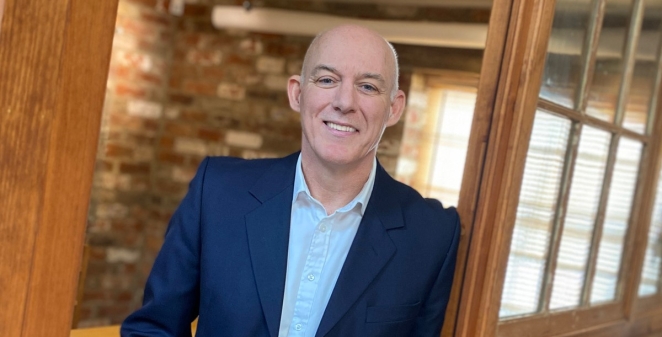
The relationship between client and agency will become increasingly collaborative as we continue to move towards more equitable ways of working. Replace the word 'client' with 'partner', we always work better when we are transparent with our partners and everyone knows their individual roles and responsibilities.
Meanwhile, the demand for data in marketing will continue to increase as we look for clearer ways to measure performance. We have more information at our fingertips than ever before, how we interpret and present this information will become critical in key business decisions and where budgets are invested.
Kirsty Vance, Associate Director Interior Design at I-AM

AI
It’s Important to remember there cannot be a substitute for human intuition, however we can be prone to revisiting the same old solutions. As agencies begin to integrate AI as part of the design process, whether for efficiency or to produce creative ideas, 2024 could see a radical change in the way we approach design challenges using AI technology.
Could this spark a new design era? As designers we are naturally biased, it’s impossible not to be limited in some way by personal taste. Could AI be the next tastemaker, creating a whole new aesthetic.
Super collaborations
We’ve seen this happen a lot in the fashion world in recent years, there have been unexpected and surprising collabs (think Supreme x LV, Gucci x Balenciaga even Greggs x Primark) I see this happening more with experiences, the most memorable example of this was Wes Anderson collaborating with Prada to create Bar Luce back in 2015.
As the fashion collabs have been more or less exhausted we might see this trend branching into physical experiences; the more unexpected, the better.
Hybrid retail
It seems the competitive landscape has changed, and value is seen in getting together/ curated collabs. Could this be how experiences add more "value" now that companies are cutting costs but not wanting to damage customer perception and spending power.
Think more mainstream collaborations in restaurants/ retail/ hotels to become hybrid retail spaces- everything is for sale; the tableware, the furniture etc.
Aaron Goldman, Chief Marketing Officer at Mediaocean

Creative Renaissance
For much of the digital age, it’s been assumed by most that the most consequential factor in advertising success or failure is targeting: the winners are those who segment audiences better, bid the exact right amount for ad space, and track consumers all the way through to purchase. 2024 will be an inflection point where creative takes over and the quality and differentiation of the message will be what decides performance.
The truth is that is has been challenging for some time to keep delivering ever-greater returns from targeting tools and bid management, but the deprecation of third-party cookies and all of the signals that rely on them will mark a fundamental shift. In the coming year, we will see forward-thinking marketers invest more in creative ad tech tools and go to market with some real innovation around how brand stories are told.
Big Tech Splits from Ad Tech
Big Tech’s relationship with ad tech could see a real shake-up in 2024 following tectonic shifts in the regulatory landscape and other macroeconomic conditions. Amazon has already announced its decision to withdraw from the third-party ad serving market, and some level of ad tech divestment looks to be a likely outcome from Google’s anti-trust issues in the US.
Meanwhile, Meta is making adjustments to EU services following a ruling over data collection policies, and the Digital Markets Act poses additional threats to the way Big Tech companies – or as the European Commission calls them, “Gatekeepers” – operate in the region.
In the big picture, this is win for marketers who will be less reliant on walled gardens to perform the critical functions of ad serving and optimisation across channels. A rising tide of independent ad tech platforms that can offer a more comprehensive and transparent approach to advertising will lift all boats in 2024.
New CTV Ad Formats
Streaming has transformed the way television is consumed but it wasn’t always clear if the model would be subscription service or ad supported. With Netflix, Disney+, and Amazon Prime all rolling out ad tiers, there’s no doubt the future of TV will include advertising. That should be reassuring news to those in the ad business as well as to consumers who won’t have to continually pay more for premium content.
Even better news for advertisers and consumers alike is that connected TV (CTV) viewing affords more relevant commercial messages and new ad formats. In the coming year, we’ll see more opportunities for brand sponsorship that go beyond 30 and 60 second spots and incorporate elements of personalisation, product placement, and interactivity.
Niche-ification of AI
If 2023 was the year AI hit the mainstream, 2024 will be the year we actually figure out how to use it. To an extent, that will mean that pragmatism retakes the reins from optimism in our thinking about AI. Rather than rely on broad apps like Chat GPT and Bard, we'll leverage the large language models (LLMs) behind them to create bespoke applications.
In much the same way that the Internet splintered from large portals to niche websites and then to apps, AI will follow the same trajectory. Recently OpenAI rolled out the ability to create custom GPTs. Think of this like when Apple first enabled apps on the iPhone. 2024 will bring dramatic innovation and adoption for niche applications of AI in our business and personal lives.
Bill Stratton, Global Industry GTM Lead, Media, Entertainment, and Advertising at Snowflake

To fully capitalize on AI, major media players will need to collaborate with each other and their respective data
Within the media industry, the inadequate scale and lack of visibility into customers' complete viewing choices is becoming a bigger challenge, and realizing the potential of AI in programming and distribution decisions must evolve beyond depending on a singular company's data.
We are already seeing this shift with producers, like Warner Brothers Discovery, licensing their previously exclusive content to other streaming platforms. How does a programmer realize the full value of its content if they are not able to get a complete view of who is watching across all platforms?
No single company has that single view so a content 360 view will require new business and data collaboration. AI will leverage not just a single company's data, but build collaborative insights from partners across the content ecosystem.
We will see this accelerate next year with streaming economics forcing licensing windows and a further rebundling of streaming and other services. Data partnerships and collaboration will become common in replacing previous competitive consumer viewership silo’s.
The companies with premium creative IP and world class storytelling will be come the true drivers of the AI revolution
In the ever-evolving landscape of the creative industry, there has been a growing concern about the impact of AI on human creativity. However, it is crucial to recognize that AI will support, rather than replace, humans in the creative process. And perhaps most importantly, AI will raise, not reduce, the value of world class storytelling and creative IP.
The recent writer's strike shed light on this issue and all sides understood that AI will fit into the creative process just like years ago when video editing and animation software enabled new forms and scale around the creative process. This expansion in the use of AI presents an opportunity for creators to further personalize creative or derive new creative by combining previous sets of sovereign IP together in an authorized manner.
There is a clear recognition that incorporating AI into the creative process can aid human ingenuity and imagination yet the final product is still managed and directed by individuals.In fact, understanding how to effectively utilize AI tools will become a vital skill set for a subset of the creative economy moving forward.
Indeed, embracing this new dynamic between humans and advancements in artificial intelligence promises to shape future developments within the realm of creativity itself.
Hyper-personalization of advertising with AI will go further than before
In the realm of advertising, we are witnessing a groundbreaking advancement in the form of hyper-personalization made possible by AI. Currently, targeting data for campaigns, where thousands of fine tuned segments can be derived from consumer behavior, has far outnumbered the creative versions of a campaign which limit ad effectiveness.
This constand versioning via AI is set to unlock a new level of performance and consumer experience. For example – AI can help reach consumers in a buying cycle with targeting and messaging to the individual every step of the way. What sets this approach apart is AI’s ability to discern someone’s distinct messaging sensitivities, or even identify which imagery resonates with that person the most at unique times.
As consumers, this breakthrough empowers us further with relevancy in our lives and will build a deeper connection between us and a brand in the process. The creative agencies and brands who embrace AI are the ones who stand to benefit the most.
The AI journey is just beginning but certainly has the promise to build a whole new connection between the consumer and brand in ways we could have never imagined before. Brands, Consumers and the Creative Process will be bonded together in the coming age of AI.
Anthony Butterfield, Head of Creative at Aer Studios

There's a lot of buzz about how generative AI is streamlining processes and saving time in the creative tech industry. However, the aspect I find most intriguing is considering how creatives will utilise all this extra time afforded by these advancements.
My prediction is that AI will assist with repetitive design and development tasks freeing up UX&D designers to spend more time on design thinking, user research, and art direction. This could lead to a renaissance in design craft, marked by the creation of a truly original, unique, and innovative UCD driven process that's sprinkled with moments of delight.
AI could be our ‘in-betweener’
In Disney's early hand-drawn animation era, keyframe artists crafted essential frames outlining a scene's major actions and poses, setting a blueprint for the animated sequence. These artists focused on pivotal moments of movement and expression.
Assistant animators, known as "in-betweeners," filled” in frames between the keyframes, smoothing out the animation. This collaboration was vital in animating characters on screen. Fast forward to today's digital product design landscape, imagine a world where AI assumes the role of the 'in-betweener' - an assistant who takes the initial designs from UI designers (the Keyframe artists) and fills in the gaps plotting out all responsive layouts or design formats.
The same could be seen for developers coding these digital experiences, They build the core skeleton of a page and auto-pilot could fill in the gaps. This taking on the more repetitive tasks could free designers and developers to spend more time crafting original and creative digital products.
Creativity lost to the MVP
During the early stages of design, teams frequently envision creative concepts, such as intricate micro-interactions, unique design embellishments, or innovative features that can make a product stand out and captivate users. However, these elements are often sacrificed in the pursuit of creating a Minimum Viable Product (MVP).
In the realm of digital product development, particularly under tight budget constraints, many of these design elements are viewed as luxuries rather than necessities. They are often set aside during the MVP phase, with the intention of incorporating them in later iterations. Unfortunately, more often than not, these creative details are overlooked and never integrated into the final product, which is truly unfortunate.
Fast-paced market demands, competitive pressures, and the need for rapid product iterations often prioritise speedy development over true creativity. Will AI help the balance between user experience vs time and budget? The first thing to get cut in a project is user experience. Could AI help get us to MVP quicker giving us time and budget to push beyond MVP and implement some of these more original and creative elements?
Why do all websites seem to look the same?
Modern web technologies offer vast design possibilities, enabling us to realise virtually any concept or layout we can imagine. We now have the tools to craft websites that are bold, unexpected, and deeply engaging. This includes blending cutting-edge typography with generative visuals and interactive elements to create truly captivating online experiences.
And yet, Is it me, or does it sometimes feel like all websites look the same with similar layouts and components with interchangeable pages, and an absence of expressive visual language? Where is the originality and design craft, It’s almost like you could switch out a brand logo and not notice the difference.
Now a lot of this is for very important reasons, such as following usability standards and conforming to UX best practices and user expectations. Maybe it’s because we have reached maturity, where we have established all the best conventions for how things should be. But I also think that the emergence of responsive design and the impact that it had on project timelines, budgets, and how we design digital products has something to do with it.
For starters, the design process became more complex and time-consuming as UI designers needed to design flexible components to cater to a wide range of devices with different screen sizes and resolutions including the time-consuming task of mocking up designs at key breakpoints such as mobile, tablet, and desktop.
Developers had to write more complex code to ensure that websites were fluid and adaptable to various devices. QA testing increased with extensive testing across different browsers and devices to ensure compatibility.
In order to save time and make it easier to adapt and respond to different screen widths, UI design has evolved and become more simplified in layout and components. We create design systems and design modular components but in this quest for flexibility, have we sacrificed a little creativity.
This isn’t necessarily a bad thing, but I wonder if it’s why everything kind of looks the same. Many of the design tools we use today such as Figma have features like auto layout that are helping speed things up, but could AI help give us back time on design and build allowing us to break this Homogeneity in design?
The future
At Aer Studios, we have fully embraced the AI revolution, integrating these tools into our everyday creative and technical workflows. We utilize ChatGPT for brainstorming and analyzing UX research findings, employ Mid-journey and Adobe Firefly for crafting visual assets for concepts and designs, and use GitHub’s Copilot for AI-assisted programming. These tools are enhancing our efficiency, but what truly excites me is the potential of the next wave of AI tools and the ways they will empower us to spend more time on design craft.
I envision a future where you can design a mobile layout for a website and then let AI handle the creation of desktop and tablet versions, allowing you to make tweaks and refinements. Imagine setting up the basic structure of a design system — outlining some foundational components, themes, buttons, colors, fonts, grids, and spacing — and then having AI expand and complete it. Or consider designing a homepage component and, with a single click, AI presents a variety of alternative compositions that haven't yet crossed your mind.
I’ve already seen that there are integrations between Figma and Webflow (a design tool that allows users to create responsive websites visually, without needing to write code), but what if in the future designers could design components in Figma and AI could transform them into production-ready robust code, so that front-end developers could concentrate less on mark-up and more on other exciting things?
These use cases could free up time allowing designers and developers to spend that time on crafting truly original and engaging user-centered designs, features, and experiences.
Will we as an industry leverage this opportunity for the good of design, or will we squander it, seduced by the cost savings AI offers, and hastily progress to the next project?
Rachael Kendrick, creative director at Livity, part of krow Group
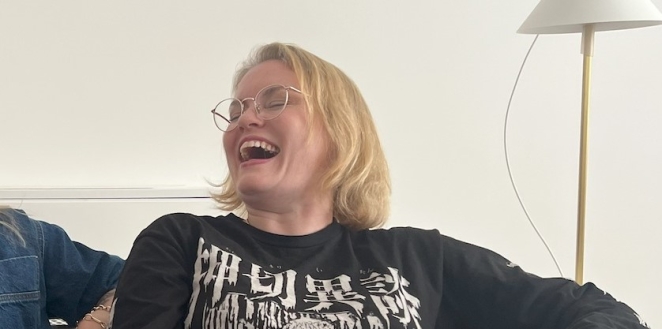
Bring beauty back
2022 was an incredible year for fashion films - Megaforce for Burberry, Torso Solutions for Mugler - but it felt like the advertising world had forgotten the art of creating singular, iconic, beautiful images.
The roaring success of EE and JD Sports’ campaigns in 2023 makes me confident that 2024 will see a return to beauty - brands finding the bravery to allow images to breathe and tell a story without scaffolding them with a million supers and VO.
Pay attention to AI culture
From the way we thumb through our Instagram feeds to the rise of content graph social, tech affordances have always shaped digital culture. And now that the AI cat is out of the bag, I’m less interested in what brands and marketers do with these tools, more the general public.
Everyone will be using AI in 2024, and this will have a major impact on culture, whether it’s people roasting Midjourney generated images (the fingers are always a dead giveaway), or artists finding truly innovative applications of the tech, like the poetry camera, that uses AI to describe what it sees in poetry.
Sarah Fritz, UK Senior Digital Strategist at Momentum Worldwide
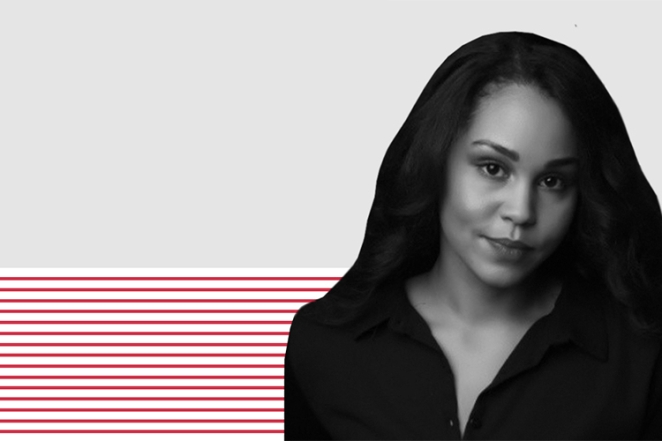
In 2024, the creator economy is poised to reach remarkable heights. Opening new doors of opportunity and innovation.
In a landscape where genuine conversations and authenticity are paramount, brands must carefully choose influencers and community members to champion their cause with real opinions.
Brands and social networks have long recognised the transformative impact of strategic talent partnerships but we have seen big developments in this space. From Meta's AI chatbots driven by celebrities to X's innovative approach that rewards creators, platforms are evolving to monetize influencers effectively and redefining content creation has been a priority.
As we step into 2024, unexplored opportunities await brands and platforms. Envision an uptick in collaborations between brands and influencers with smaller yet highly engaged communities.
Peer trust remains paramount, and brands spotlighting nano talent and unique perspectives from their communities will triumph. 2024 is set to prioritise valuing community over follower count and credibility over noise, marking a significant shift in the dynamics of the creator economy.
Fleur Cuyalaa, Associate Creative Director at FutureBrand

Whilst 2023 was a big year for forms of accessible AI that transformed the way that designers and creatives interact with their work, 2024 is expected to be a continuation of this, with companies and individuals looking at the tool as a great source of potential to expand and redefine how we view and play with our own creativity.
The impact of technological advancements on the creative process is already starting to have a tangible effect on branding – with the emergence of futuristic designs that blur the line between machine and user. From vivid neon and holographic colour palettes and finishes to the subtle art of merging 2D & 3D to create a unique immersive space, 2024 should carry over those trends.
We foresee more designs, illustrations and photography inspired by technology – gaming in particular – with a new aesthetic acting as a catalyst to ignite and bring to life brand assets that are both dynamic and engaging. As we continue to engage with tools like AI , we can push the boundaries of what we can do in branding.
If we had to encapsulate the overarching feeling of the past year; 2023 seems to have been the year of self-expression & innovation; and as we look ahead, 2024 could suggest to go beyond with a real deep dive into even more experimental & immersive design.
James Ramsden, Executive Creative Director, Coley Porter Bell

Simplification, reduction and flat design will remain a steadfast trend in 2024 as global enterprises collectively continue their movement toward simplicity, enabling interactions to take place at speed. Consequently, differentiation and distinctiveness will become increasingly important as brands require unique equities, assets or experiences to define their brand. The more sensory and immersive, the better.
The development of AI will enable brands to achieve greater personalisation. Over the next few years we will see AI incorporated into design systems to make them more adaptive, fluid and reactive, enabling brands to reflect and mirror our moods, contexts and moments more intuitively.
Sound has joined motion and finally moved to centre stage, and we will see more brands created and evolved with sound as an integral part of their expression. Motion once felt like like an ‘add-on’, but it’s now as much a part of the brand expression as say colour, or type. As it should be. Sound will continue this trajectory to be an integral part of how we think about brands and their design systems through 2024.
Michael Knowles, founder at ROAR Digital Marketing
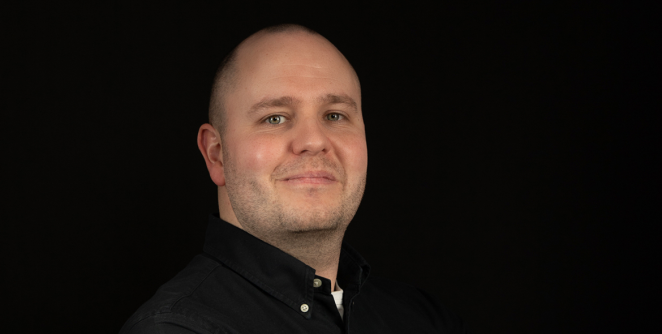
Advanced AI will become businesses’ best friend, not foe
The march of AI will result in the likes of ChatGPT becoming the most powerful ally of marketing departments the world over, a leading digital specialist has predicted.
As AI systems become increasingly intelligent, more businesses than ever before are enlisting the help of robots to improve their SEO status and boost their search engine rankings as a way of increasing their visibility to a wider online audience.
Michael Knowles, a former Google trainer and senior lecturer, predicts that AI will continue to develop in terms of higher levels of personalisation, improved accuracy of information it provides and adopting everyday language including humour and slang, and these characteristics will increase the brain power of humans working on their next major marketing campaign.
“The current AI systems utilised by a lot of businesses are incredibly intelligent and sophisticated, many of which blow your mind at how clever the automated responses are,” said Michael, who founded ROAR Digital Marketing in 2016.
“But we haven’t seen anything yet.
“The levels of personalisation will increase significantly to replicate human behaviour and attributes more accurately, and more relevant and correct information will be readily accessible at the press of a button.
“The technology and algorithms used by AI will become so intelligent to the point where the systems will be able to immediately analyse search engine patterns and data, and enhance the user experience, to inform businesses what steps to take to improve their search engine rankings, tailor content and ultimately help brands adapt their approach and communicate more effectively to their users.
“Businesses, however, need to be careful not to be over-reliant on AI to generate content - whether written, imagery or video - because search engine algorithms are equally as intelligent, and they analyse material and, as advised many times by Google already, prefer to rank original human-generated content higher than artificially produced text.
“The strength of AI for businesses lies in instantly coming up with new ideas and creating content to supplement parts of other texts, for example headlines, to allow marketing departments to work much more efficiently.”
Reflecting on the increased popularity of AI among businesses, Michael has been buoyed by the receptiveness of companies implementing the new technology.
Marketing departments have welcomed the advanced AI with open arms to help with ideas for videos, written content and social media posts.
Removing the human element from marketing campaigns, however, would be disastrous for businesses, argued Michael.
He said: “Humans are, and always will be in my opinion, key to understanding business’ true values and ethics, as well as being aware of the brands’ personality and messaging. Robots don’t come anywhere near when it comes to these emotive aspects.
“More businesses are integrating AI into their daily operations, and most to good effect, but a whole load more is yet to come, and I predict that things will develop at a rate of knots within the next year.
“What we will see is that AI will become the norm and not just be used as an add-on to most software and platforms. It will form a part of all digital marketing packages, and it will soon be unusual if the technology isn’t accessible for everybody in an instant.
“There are exciting times ahead with AI and businesses can expect to benefit from implementing it, if embraced fully and not opposed. That is not to say that AI can ever truly replace people as that important human connection and emotive element is always required, plus AI content faces search engine updates and AI monitoring that can potentially hinder its performance.”
Cormac Ó Conaire, Chief Design Officer at PA Consulting

The human will return to the Generative AI design process
Generative AI (GenAI) will amplify our abilities, not replace them. Throughout history, industrial revolutions have consistently stirred trepidation – from the uprisings against textile machines in the 18th century to the skepticism around the internet in the 1990s. Yes, AI and machines will replace human jobs.
But as technology evolves, our role on this planet evolves with it. GenAI has huge potential in augmenting human capabilities, empowering us to work faster and become more creative. GenAI need not be our replacement; rather, it serves as our amplification. The focus on GenAI's abilities often overlooks the fact that its potential is unlocked by human ingenuity.
Meaningful design is determined by people. Design, at its core, addresses complex problems that hold relevance and meaning for people. What dictates if something is meaningful? GenAI's ability to produce output that is authentic and purposeful is a decision ultimately made by people.
In this context, a designer's oversight – embracing creative direction, decision-making, intuition, and authenticity – is more pertinent than ever. As we enter 2024, and GenAI updates continue to amaze us, the significance of these human qualities will also come to the fore. Remarkable designers have always acted as curators of meaningful stories.
Consider Jony Ive's unwavering vision for the iPhone, Alexander McQueen's fusion of boundless imagination with exceptional technical skill to bring his ideas to reality, and Zaha Hadid's architectural marvels. While GenAI may sharpen our insight and liberate us from the constraints of our imaginations, its success will prove elusive unless we infuse it with purpose."
Video gaming will start to influence the healthcare sector/future surgery
There are parallels between gamers and surgeons. Gamers and surgeons may seem worlds apart, but they share important traits – precision, accuracy, visual-spatial skills, and a knack for being fully absorbed in what they're doing. With the gaming market estimated to hit over $600 billion by 2030, investment is fuelling new innovations in bleeding-edge, highly immersive control experiences.
Led by the growth of eSports, the focus on bringing even more precision and accuracy to competitive gaming controls is paramount. This involves maximising in-game efficiency while minimising the risk of mistake – a direct parallel with the healthcare industry and surgical operations.
Surgeons will increasingly need to control robotic devices. Robotic surgery steps in to address the challenges faced by human surgeons, but it introduces a whole new dynamic to the control experience for surgeons.
Managing robotic devices demands prolonged screen focus, precise control, and unconventional postures. To ensure surgeons stay deeply engaged in the evolving field of surgery, the healthcare sector will start to draw insights from the world of video gaming.
Designing for ‘sensory engagement’. One effective way to enhance immersion is by designing for the senses. At PA, we call this 'sensory engagement.' While most people are familiar with the common five senses, humans have anywhere between 10-33 senses, depending on the classification.
Creating experiences that tap into these senses can lead to quicker intuition, improved accuracy, and the ability for surgeons to use complex devices without needing to glance at the controls. This year witnessed the rise of video games to train healthcare professionals in various medical disciplines. I see this trend going far beyond surgical devices and influencing all kinds of gamified healthcare experiences in 2024.”
Healthcare takes design for sustainability seriously
Current challenges with embedding sustainability in healthcare. Reimagining how we sustainably design, produce, utilise, and dispose of products and services is imperative. A recent report shows that healthcare’s climate footprint is 4.4% of the global total. If it were a country, it would be the fifth largest emitter on the planet.
Yet designing for sustainability in healthcare proves inherently challenging. Achieving positive outcomes, such as reducing infections, currently often comes at the expense of negative side effects, like increased waste. This dilemma paints medical waste as an unfortunate but seemingly unavoidable consequence of improved treatment. In prioritising patient well-being and efficacy, the question arises: where does sustainability fit in?
2024 marks a turning point for sustainability in healthcare. 70% of healthcare’s carbon emissions fall under 'Scope 3,' meaning they are indirect and outside the direct control of the sector, residing in their supply chain and off-site waste treatment. In response to this, governing bodies and healthcare institutions are imposing penalties on companies failing to comply with net-zero goals.
The NHS is signalling that, by as early as 2027, it will no longer do business with non-compliant supply chain partners unless they demonstrate environmental impact reductions. To substantiate their claims, manufacturers will need to conduct bottom-up assessments that quantify the emissions arising from their medical products and therapies – called Life Cycle Assessments.
Simultaneously, a groundswell of people advocating for change is emerging, exemplified by initiatives like the Green Diabetics Initiative, dedicated to reducing diabetes device waste. With global regulatory pressures and rising compliance costs, as well as these consumer demands, 2024 marks a turning point for the healthcare industry. We will see the industry embracing new, optimistic approaches to sustainable innovation and design for sustainability in the year ahead.
Stefanie Briec, Director, Head of Demand Sales UK & INTL at FreeWheel

We expect to see the transition into the deprecation of third-party cookies next year, and the industry as a whole will be seeking viable alternatives for targeted advertising. According to AudienceXpress research, access to data remains a key priority for advertisers; in the post-cookie world, they will require tech solutions that offer a granular approach to data.
This will mean greater transparency and access to raw campaign data to optimise ad buys and retain control over supply. Ultimately this will enable brands to be more efficient and develop unique creative campaign strategies.”
Chris Hogg, Chief Revenue Officer at Lotame
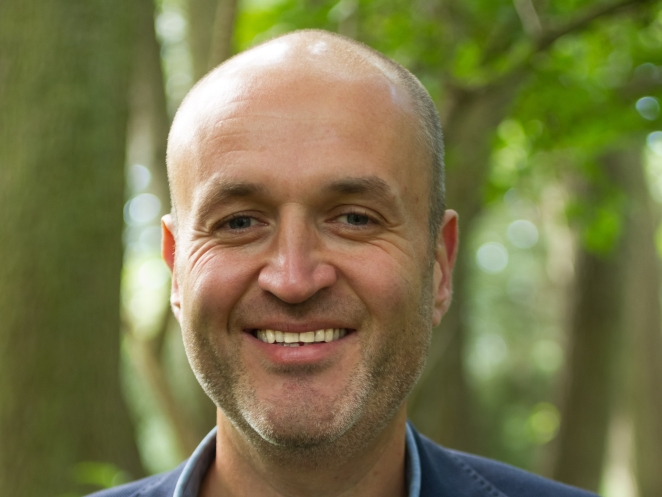
The fallout from Google’s antitrust battles and Meta’s clashes with the EU may make us hopeful that big tech’s grip on digital advertising will be loosened, but a weakened duopoly just means other giants jostling for the top spot. Google and Meta’s lost market share will be eaten up by Amazon and The Trade Desk. As for social media, all bets are off from the moment TikTok finally rolls out a full-fledged advertising suite.
Meanwhile, Apple will continue to quietly build a huge advertising business within its Appstore ecosystem, leveraging its control of its platform and exclusivity over the data it generates to clamp down on its advertising competitors, all without denting the halo effect of its consumer-first reputation.
But the EU has shown that it doesn’t like big tech writing its own rules, even within its own platforms, and USB-C on iPhones is just the beginning of regulators chipping away at the most stubborn walled garden in the industry.
Joseph Worswick, VP of EMEA, Global Head of Sustainability at OpenX

Moving forward, partnerships that prioritise responsible media and sustainable buying practices across platforms will ensure long-term rewards in a competitive advertising landscape. Curation, which has been triggered by MFA and a general need to clean up the supply chain will enable both brand safety and innovative targeting solutions that most effectively seize the opportunities that lie ahead.
Additionally, the rapid growth of CTV will continue into 2024, with the promising channel likely to take the centre stage of advertising trends. Next year I’d expect to see the continued emergence of new creative trends within this format – as we’ve previously seen with the likes of ‘ad podding’. However, we must first tackle the fragmented user landscape of CTV and deliver superior, more coherent consumer experiences.
Edward Wale, VP, Europe, LG Ad Solutions

CTV, fundamentally powered by AI, will continue to evolve under its influence. AI's expanding capabilities are reshaping every facet of advertising, and CTV is no exception. It enhances targeting by analysing data more effectively, ensures brand safety and suitability through precise content assessment, and dynamically optimises creative content for an improved audience experience.
It will also revolutionise many of the more labour intensive tasks – such as creating assets for multiple channels from one piece of creative – allowing marketers to focus more on strategy and creativity.”
Ad-supported CTV will continue to surge. While we see trends of subscription cycling – when consumers cancel a service once they are done watching the content – to continue watching their favourite content, they are increasingly tuning into advertising-supported streaming services. With Netflix, Disney+, and Amazon all launching ad-supported tiers, it's clear that this model will only increase in popularity over the next year – good news for advertisers.
FAST will come to the fore. This shift to ad-supported streaming models will mean that more viewers than ever before will start to watch free ad-supported streaming TV (FAST) channels. For advertisers, FAST presents a unique opportunity. CTV viewers are not only more receptive to ads on these channels, but their often niche nature means that marketers can more easily find and target their desired audience.
The home screen will become increasingly important. On average, it takes audiences six minutes to navigate a smart TV home screen and choose the content they want to watch. This window is an increasingly important opportunity for advertisers – especially as the CTV landscape continues to fracture. The smart TV homescreen offers a solution to reaching audiences, in order to cut through the noise and reach audiences before they’ve even chosen their content.
The CTV tipping point is coming. Slowly but surely, audiences are choosing CTV as their way of viewing content. Marketers need to start preparing for the inevitable. Many will need to restructure how they buy CTV ads as it shifts from a way to gain incrementality to being the main way to reach audiences; those that start preparing now will find themselves ahead when the tipping point is reached.
Nick Pinks, CEO at Covatic

Linear TV will continue to decline, as consumers access their favourite shows and content through a wide variety of channels and platforms. With economic factors still impacting subscription services, free ad-supported streaming TV (FAST) channels will grow in popularity with consumers – with marketers following suit.
FAST platforms offer advertisers access to large audiences against recognisable, linear TV-type content, as well as on-demand content; combining the best of linear and digital. Since FAST is over-the-top (OTT) content, information is sent to the app and can also be sent back, providing a better understanding of who is watching.
FAST can also be coupled with innovative targeting solutions, such as on-device technology, to make it more addressable, enabling brands to serve tailored, contextualised, and relevant content to key audiences.”



